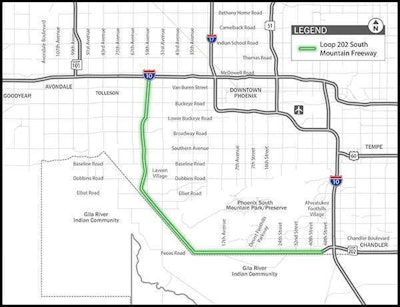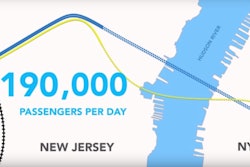Work can begin on the Loop 202 South Mountain Freeway, an I-10 connector that extends south of downtown Phoenix, after the U.S. District Court there determined the Federal Highway Administration (FHWA) and the Arizona Department of Transportation (ADOT) were not negligent in meeting federal laws on the project.

They contended FHWA and ADOT did not meet their obligations under the National Environmental Policy Act (NEPA) and that they had “critical flaws” in their process to assess the impacts of the project and its approval that were “arbitrary, capricious and an abuse of discretion” and were designed to “rationalize a preordained decision” and “did not adequately consider the potential health effects to children who live and attend school near the proposed freeway.”
GRIC also contended the two agencies worked off of “incomplete data” and didn’t “evaluate the unique impacts of the project on their community, its members or the affect animal and plant life” in the area.
The judge found in the ruling released last week that PARC and GRIC didn’t demonstrate that FHWA and ADOT failed to meet NEPA requirements in addition to other federal laws.
“Plaintiffs have not met their burden to show the agencies’ actions were ‘arbitrary, capricious, an abuse of discretion, or otherwise not in accordance with law …’ or ‘without observance of procedure required by law,’ ” the ruling states.
ADOT Director John Halikowski says the ruling created a “momentous day” for the partners on the project, which he says was the most extensive environmental review to date of a highway in the state.
“More importantly, this is a clear victory for the region, which will benefit from a new transportation corridor and, with it, the economic development that will follow,” he says. “This east-west alternative will connect people with employment, entertainment and educational centers in parts of the Phoenix metropolitan area that are projected to see considerable growth.”
ADOT says construction on the project will begin in early September at the I-10/Loop 202 (Santan Freeway) interchange, with native plant relocation along the right of way beginning at nearly the same time.
The project, extending 22 miles, is expected to open in late 2019. It is expected to provide a direct link between the East Valley and West Valley areas and give an alternative to I-10 through downtown Phoenix.
The project has been in the works since 1985 when Maricopa County voters approved the project initially. Voters gave it a thumbs up again in 2004 as part of a comprehensive transportation plan, ADOT says.
The South Mountain Freeway would complete the Loop 101 and Loop202 freeway system, the agency adds. More details on the project are available at azdot.gov/SouthMountainFreeway.












